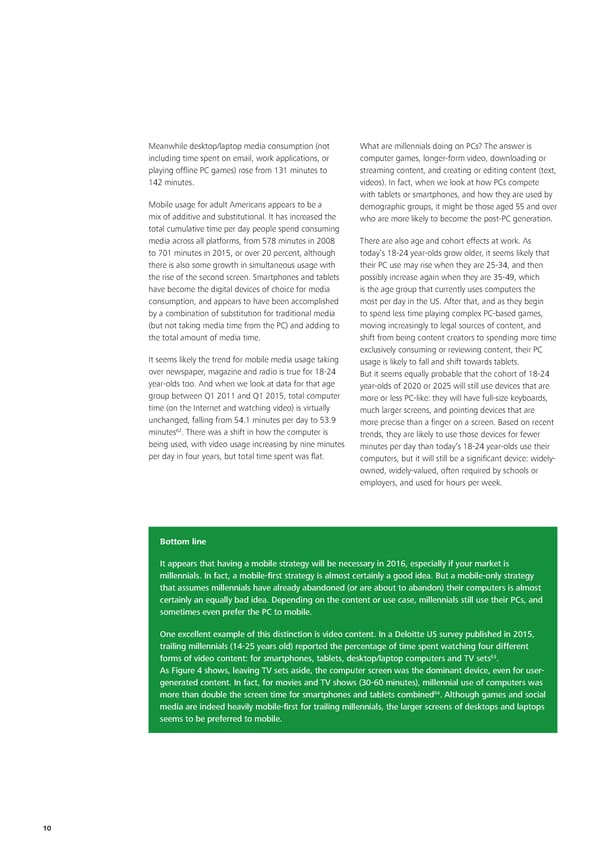Meanwhile desktop/laptop media consumption (not What are millennials doing on PCs? The answer is including time spent on email, work applications, or computer games, longer-form video, downloading or playing offline PC games) rose from 131 minutes to streaming content, and creating or editing content (text, 142 minutes. videos). In fact, when we look at how PCs compete with tablets or smartphones, and how they are used by Mobile usage for adult Americans appears to be a demographic groups, it might be those aged 55 and over mix of additive and substitutional. It has increased the who are more likely to become the post-PC generation. total cumulative time per day people spend consuming media across all platforms, from 578 minutes in 2008 There are also age and cohort effects at work. As to 701 minutes in 2015, or over 20 percent, although today’s 18-24 year-olds grow older, it seems likely that there is also some growth in simultaneous usage with their PC use may rise when they are 25-34, and then the rise of the second screen. Smartphones and tablets possibly increase again when they are 35-49, which have become the digital devices of choice for media is the age group that currently uses computers the consumption, and appears to have been accomplished most per day in the US. After that, and as they begin by a combination of substitution for traditional media to spend less time playing complex PC-based games, (but not taking media time from the PC) and adding to moving increasingly to legal sources of content, and the total amount of media time. shift from being content creators to spending more time exclusively consuming or reviewing content, their PC It seems likely the trend for mobile media usage taking usage is likely to fall and shift towards tablets. over newspaper, magazine and radio is true for 18-24 But it seems equally probable that the cohort of 18-24 year-olds too. And when we look at data for that age year-olds of 2020 or 2025 will still use devices that are group between Q1 2011 and Q1 2015, total computer more or less PC-like: they will have full-size keyboards, time (on the Internet and watching video) is virtually much larger screens, and pointing devices that are unchanged, falling from 54.1 minutes per day to 53.9 more precise than a finger on a screen. Based on recent 62 minutes . There was a shift in how the computer is trends, they are likely to use those devices for fewer being used, with video usage increasing by nine minutes minutes per day than today’s 18-24 year-olds use their per day in four years, but total time spent was flat. computers, but it will still be a significant device: widely- owned, widely-valued, often required by schools or employers, and used for hours per week. Bottom line It appears that having a mobile strategy will be necessary in 2016, especially if your market is millennials. In fact, a mobile-first strategy is almost certainly a good idea. But a mobile-only strategy that assumes millennials have already abandoned (or are about to abandon) their computers is almost certainly an equally bad idea. Depending on the content or use case, millennials still use their PCs, and sometimes even prefer the PC to mobile. One excellent example of this distinction is video content. In a Deloitte US survey published in 2015, trailing millennials (14-25 years old) reported the percentage of time spent watching four different 63 forms of video content: for smartphones, tablets, desktop/laptop computers and TV sets . As Figure 4 shows, leaving TV sets aside, the computer screen was the dominant device, even for user- generated content. In fact, for movies and TV shows (30-60 minutes), millennial use of computers was 64 more than double the screen time for smartphones and tablets combined . Although games and social media are indeed heavily mobile-first for trailing millennials, the larger screens of desktops and laptops seems to be preferred to mobile. 10
 Technology, Media & Telecommunications Predictions Page 14 Page 16
Technology, Media & Telecommunications Predictions Page 14 Page 16